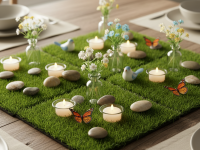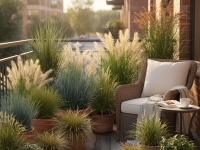Hey there, fellow home decor enthusiast! Have you ever scrolled through Instagram or Pinterest and just been mesmerized by those effortlessly chic arrangements of dried grasses and pampas? They seem to whisper tales of earthy elegance, bringing a touch of nature’s tranquility right into our living spaces. I know I have! And if you’re anything like me, you’ve probably wondered, “How do they make it look so good? How do I get that perfect blend of textures and heights?”
Well, you’re in the right place! As someone who’s spent countless hours experimenting with different types of dried botanicals, I’m excited to share my go-to tips and tricks for mixing dried grass and pampas like a seasoned pro. It’s not just about sticking them in a vase; it’s an art form, a symphony of textures and subtle colors. And trust me, once you get the hang of it, you’ll be creating breathtaking displays that feel truly unique to your home. So, grab a cup of tea, and let’s dive into creating some serious home decor magic!
Why Dried Grass & Pampas Have Captured Our Hearts
Before we get our hands dirty (or rather, a little dusty!), let’s chat about why these natural beauties are such a hit. For me, it’s their understated charm and incredible versatility. Unlike fresh flowers that have a short lifespan, dried grasses and pampas offer lasting beauty, a sustainable option that keeps your home feeling fresh and stylish for months, even years! They bring an organic, bohemian, yet undeniably sophisticated vibe that complements almost any decor style, from minimalist modern to rustic farmhouse. Plus, they introduce a gorgeous textual dimension that can really elevate a room without being overly loud or colorful.
The gentle sway of pampas plumes and the intricate details of dried grass stems create a dynamic, living texture that softens hard lines and adds warmth. I’ve personally found that they’re perfect for adding height and drama without the constant upkeep of fresh plants. It’s a win-win!
Understanding Your Materials: A Tale of Two Textures
To truly master the mix, it’s essential to understand the stars of our show:
The Majestic Pampas Grass
Ah, pampas! Known for its fluffy, cloud-like plumes, it’s the showstopper of many a dried arrangement. Pampas brings volume, softness, and a dreamy, airy quality. It typically comes iatural beige, cream, or sometimes bleached white, offering a neutral palette that’s incredibly easy to work with. When I first started, I was worried about it shedding everywhere, but a little hairspray post-arrangement does wonders!
The Diverse World of Dried Grasses
This is where the real fun begins! “Dried grass” is a broad category, encompassing a fascinating array of textures, shapes, and subtle colors. Think about:
- Rabbit Tail Grass (Lagurus): Super cute and fluffy, great for adding smaller, soft accents.
- Wheat Stems: Classic, golden, and brings a rustic, harvest feel. Perfect for adding a structured, linear element.
- Reed Grass: Taller, slender, and can add height and a slightly more architectural feel.
- Foxtail Grass: Offers a unique texture, often with a slightly feathery, elongated shape.
- Eucalyptus (dried): While not strictly a grass, dried eucalyptus often gets paired with grasses for its beautiful muted green tones and delicate leaf structure. It adds a lovely aromatic touch too!
Each type brings its own personality to the mix. My advice? Don’t be afraid to collect a variety! The more textures you have to play with, the richer your arrangement will be.
Getting Started: The Essentials You’ll Need
Before you start arranging, let’s gather a few things:
- Vases: This is crucial! Consider the height and width of your space and your grasses. Tall, narrow vases work well for just a few dramatic pampas plumes, while wider, more open vases are perfect for mixed arrangements. Ceramic, stoneware, or even clear glass can all look stuing. I often choose vases with a narrower neck to help corral the stems.
- Shears or Sharp Scissors: For trimming stems to your desired height.
- Hair Spray (Strong Hold): A secret weapon to minimize shedding from pampas and some dried grasses.
- Gloves (Optional): If you’re sensitive to dust or tiny fibers.
- A Clean Workspace: Trust me, dried grasses can be a little messy initially!
The Art of Layering: A Step-by-Step Guide to Mixing
This is where the magic truly happens! My approach focuses on building depth and visual interest.
1. Establish Your Base (The Tallest Elements)
Start with your tallest pieces, which are often your pampas grass plumes or the longest dried grass stems. Place them in the center or slightly off-center of your vase. Don’t crowd them! Give them room to breathe and show off their natural arch. I usually go for an odd number (3 or 5) for a more organic, balanced look.
2. Introduce Your Mid-Height Fillers
Now, bring in your secondary, slightly shorter dried grasses. This could be wheat, reed grass, or longer foxtail. Place these around and slightly below your pampas base. The goal here is to start filling out the arrangement and bridge the gap between your tallest elements and the rim of the vase. Vary the heights slightly even within this layer to avoid a “chopped off” look.
3. Weave in Your Textural Accents (The Smaller Details)
This is my favorite part! Use smaller, more delicate grasses like rabbit tails or other unique textures to fill in any gaps and add intricate details. These pieces are wonderful for softening the edges and adding a whimsical touch. Think of them as the “spice” of your arrangement, adding those little pops of interest.
4. Check Your Angles & Balance
Step back and look at your arrangement from different angles. Is it balanced? Does it have good depth? Sometimes, rotating the vase or adjusting a single stem can make a huge difference. You want it to look natural and effortless, not too stiff or symmetrical. I often aim for a slightly asymmetrical look, which feels more organic.
5. The Hairspray Trick!
Once you’re happy with your creation, give the entire arrangement a light, even mist of strong-hold hairspray. This helps to seal the delicate fibers and drastically reduce shedding. Do this outdoors or in a well-ventilated area, then let it dry completely before moving it to its final spot.
Color Play & Texture Talk
While dried grasses often come iatural, muted tones, don’t underestimate the power of subtle color and texture variations! Pairing a creamy white pampas with the golden hues of wheat stems creates a warm, inviting palette. Introducing darker, more structured elements like dried palm spears or even some dark brown eucalyptus can add depth and contrast.
Think about how different textures play off each other: the feathery softness of pampas against the rigid linearity of wheat, or the delicate fluff of rabbit tails beside the intricate patterns of dried protea leaves. These contrasts are what make an arrangement truly captivating.
Placement Prowess: Where to Style Them
Once your masterpiece is complete, where should it go? The beauty of dried arrangements is their versatility:
- Living Room: A grand statement on a console table, a subtle touch on a coffee table, or filling an unused fireplace hearth.
- Bedroom: Softens the bedside table or adds an ethereal touch to a dresser.
- Dining Area: A stuing centerpiece for your dining table (just make sure it’s not too tall to obstruct conversation!).
- Entryway: A welcoming display that sets the tone for your home.
- Bathroom: Yes, even the bathroom! A small, textural arrangement can add a spa-like feel.
Consider the scale of the room and the furniture. A large, dramatic arrangement needs space to shine, while a smaller, more intimate mix might be perfect for a shelf or a desk.
Beyond the Vase: Creative Combinations
Don’t limit yourself to just vases! Dried grasses and pampas can be incorporated into:
- Wall Hangings: Create a bohemian wall art piece by tying bundles to a wooden dowel.
- Wreaths: Weave them into a simple wire frame for a unique door or wall decoration.
- Garlands: Drape them over a mantelpiece or shelf for a natural, flowing look.
- Incorporating Dried Flowers: For an extra pop, mix in dried lavender, statice, or even delicate dried roses for a touch of color.
The possibilities are truly endless once you start seeing dried botanicals as flexible artistic mediums.
Maintenance & Longevity
The best part about dried arrangements? They’re incredibly low maintenance! To keep them looking their best:
- Keep them Dry: Avoid high-humidity areas or direct contact with water.
- Out of Direct Sunlight: While they’re already dried, prolonged direct sunlight can cause colors to fade over time.
- Gentle Dusting: Every few months, use a hairdryer on a cool, low setting or a soft duster to gently remove any accumulated dust.
With a little care, your beautifully mixed arrangement will bring joy to your home for a very long time.
Your Journey to Dried Decor Excellence
Mixing dried grass and pampas for home decor isn’t just about following rules; it’s about finding your own style, experimenting with textures, and creating something that speaks to you. I encourage you to play around, try different combinations, and trust your eye. Each arrangement you create will bring a unique touch of natural elegance and warmth to your home.
So, go ahead, get creative, and transform your space with these whispering wonders. I can’t wait to see what beautiful compositions you come up with!


